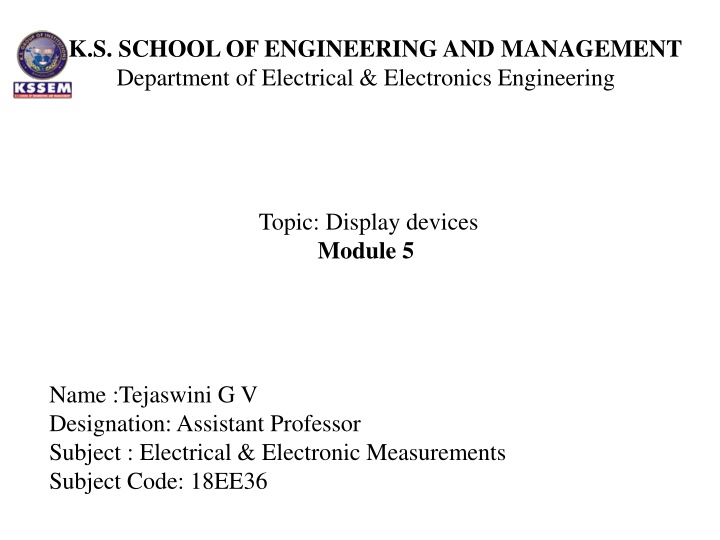
LED Display Devices and LCD Technology Overview
Learn about Light-Emitting Diodes (LEDs) and Liquid Crystal Displays (LCDs) in this informative module. Understand how LEDs work, the types of LEDs available, and the functioning of LCD technology. Discover the features and benefits of LCD displays compared to other display devices.
Download Presentation

Please find below an Image/Link to download the presentation.
The content on the website is provided AS IS for your information and personal use only. It may not be sold, licensed, or shared on other websites without obtaining consent from the author. If you encounter any issues during the download, it is possible that the publisher has removed the file from their server.
You are allowed to download the files provided on this website for personal or commercial use, subject to the condition that they are used lawfully. All files are the property of their respective owners.
The content on the website is provided AS IS for your information and personal use only. It may not be sold, licensed, or shared on other websites without obtaining consent from the author.
E N D
Presentation Transcript
K.S. SCHOOL OF ENGINEERING AND MANAGEMENT Department of Electrical & Electronics Engineering Topic: Display devices Module 5 Name :Tejaswini G V Designation: Assistant Professor Subject : Electrical & Electronic Measurements Subject Code: 18EE36
MODULE 5 DISPLAY DEVICES
What is an LED? Light-emitting diode Semiconductor Has polarity
LED: How It Works When current flows across a diode Negative electrons move one way and positive holes move the other way
Contd The wholes exist at a lower energy level than the free electrons Therefore when a free electrons falls it losses energy
Contd This energy is emitted in a form of a photon, which causes light The color of the light is determined by the fall of the electron and hence energy level of the photon
Inside a Light Emitting Diode 1. Transparent Plastic Case 2. Terminal Pins 3. Diode
LIQUID CRYSTAL DISPLAY (LCD) A liquid-crystal display (LCD) is a flat panel display that uses the light modulating properties of liquid crystals. Liquid crystals do not emit light directly, instead using a backlight or reflector to produce images in colour. The different arrangement of these rod like molecules leads to3 main categories of liquid crystals. 1. Smectic 2. Nematic 3. Cholesteric
Features of LCD Cost effective Energy efficient Lighter weight Improved image quality/contrast Better screen privacy Long life Easy options and features Used in projection system as slides so that enlarged image can be easily obtained. Turn on time is few milliseconds turn off time 10 milliseconds so these are slow devices.
Advantages of LCD Less power consumption Low cost Uniform brightness with good contrast Low operating voltage and current
Disadvantages of LCD Limited temperature range. Poor visibility in low ambient temperature. Slow speed. Requires an ac drive.
DOT MATRIX Displays It uses LED at each dot location in the matrix. It is formed with the wiring patterns. Commonly used dot matrices are 5X7, 5X8,7X9out of three patterns 5X7 is most commonly used.
DOT MATRIX Displays (5X7 display)
Nixie tubes have the following important characteristics: The numerals are usually large, typically 15-30 mm high, and appear in the same base line for in- line read-out. Nixie tubes are single digit devices with or without a decimal point. Most Nixie tubes require dc supply of 150-220 V, and the selected cathode carries current in the range of 1-5 mA. The Nixie tube can be pulse operated and hence can be used in multiplexed displays. Alphabetical symbols can also be introduced in the Nixie tube.
NPTEL & YOUTUBE Video Links https://nptel.ac.in/courses/108105064/ http://www.nptelvideos.in/2012/11/industrial -instrumentation.html https://www.youtube.com/watch?v=BH9LI973 H8w https://www.youtube.com/watch?v=Bf3547W B5qs https://www.youtube.com/watch?v=GzMh4q- 2HjM
